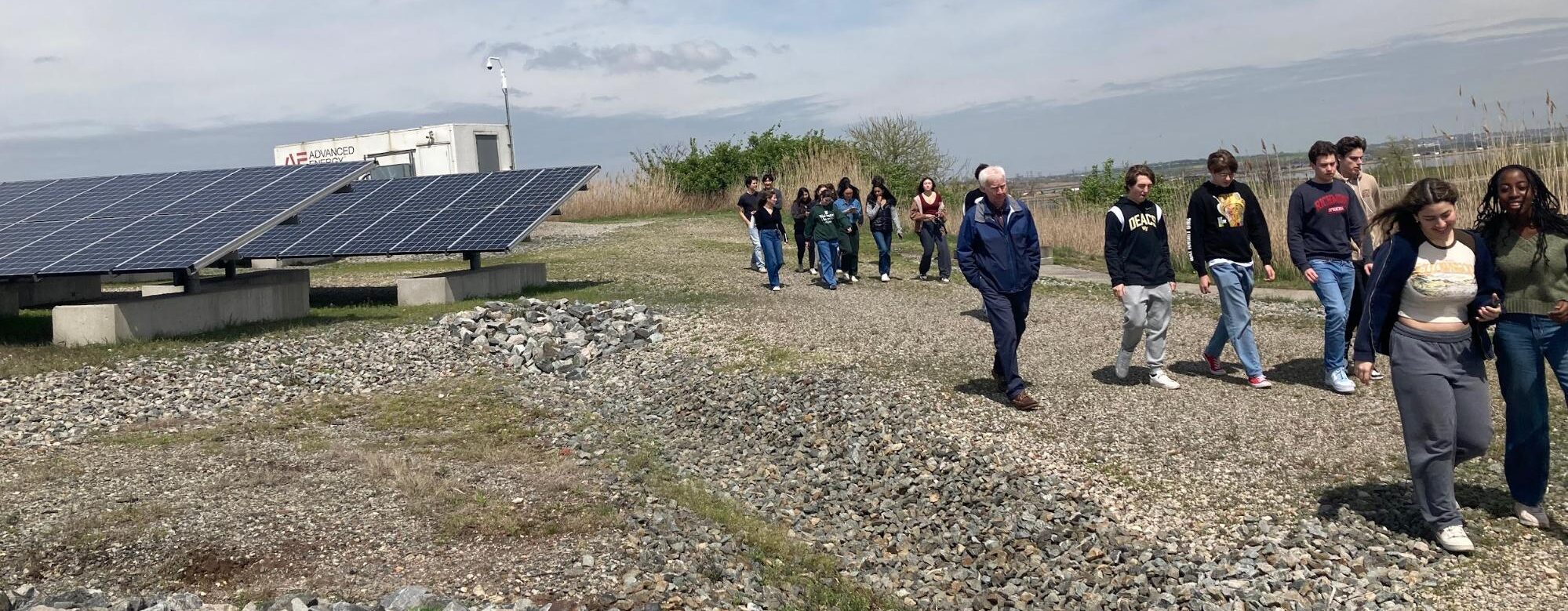This Spring, the AP Environmental Science class went on three field trips to get some firsthand experience with various aspects of Environmental Science.
The first trip was to the Columbia Lamont-Doherty Earth Observatory and to the Hudson River Field Station, operated by the Observatory. This trip was a collaboration between the AP Environmental Science and AP Biology classes, and occurred as part of PAW (Projects and Assessments Week). At the Field Station, located at the end of Piermont Pier, students learned about the Hudson River Watershed, conducted a variety of chemical tests on water samples fresh from the river, and learned how to use a Secchi disk to measure the turbidity (amount of suspended particles) of the water. They also had a chance to examine a freshly-collected sediment core from the bottom of the river.
Then, following a brief intermission for lunch, students had a chance to explore the Core Repository at the Lamont-Doherty main campus, one of the largest repositories of ocean sediment cores in the world. Differences in core layers provided students with evidence of past changes in the Earth’s climate. Students also used the opportunity to review plate tectonics, with large maps on the walls showing the various plate boundaries. Students also learned how magnesium nodules form on the sea floor in thin layers over millions of years, and the environmental consequences of mining such a unique, non-renewable resource. Lastly, students had the opportunity to examine under a microscope the tiny shells of phytoplankton to see how they decreased in complexity following the asteroid strike 65 million years ago.
Shortly after returning from Spring Break, the class was back on the road, this time visiting the Veolia Water Treatment Plant in Haworth, NJ. This plant filters water from the Oradell Reservoir, which is then supplied to households and institutions across most of Bergen County, including Dwight-Englewood. The tour of the facility began with a lesson about the basics of watersheds, reservoirs, and dams. After this introduction, everyone was asked to put on hardhats, protective glasses and yellow vests for safety purposes, to the great excitement of many. This was followed by a walk onto the dock where intake pipes pull in water from the reservoir for filtration, where students were surprised by the sound of gunshots behind them – this was a recording played at regular intervals, which is designed to keep ducks away from the reservoir, as they can pollute the water with organic matter.
Next, the group was taken into the facilities lab, which tests hundreds of water samples at various stages in the filtration process every week. Small groups rotated through stations, where scientists explained various aspects of the testing process. At the microbiology station, students had the chance to see naturally-occuring bacteria under a microscope. The microbiologists also showed how if there was any bacteria present in a sample, they would become visible as colonies on a petri dish within just a few hours. At the titration station, chemists explained how they used titration to determine the alkalinity of the water. Lastly, at the mineral station, chemists explained how they used plasma mass spectrometry to identify the quantities of magnesium, iron, and other metals present in the water. This was the first D-E class ever to have the opportunity to see the lab, as most of the time the scientists are busy performing their tests!
After having toured the lab, the group saw how the scum which floated to the top of the water was skimmed off using a giant scraping mechanism. Unfortunately, at this point the group was short on time, so some steps in the filtration process were skipped, although the group did have a chance to see the water being filtered through anthracite (a type of coal) and sand. At the end of the tour, students had the chance to try the water as it came out of the final filtration step. According to one student, “it tasted like water.”
The final trip of the season was to a solar farm operated by PSE&G, located in Kearny, NJ. This trip had been rescheduled four times due to bad weather, so when the class found out the night before the trip that they were at last going, everyone was very excited. The trip included an explanation of how solar panels work, as well as some review about how buying RECs (Renewable Energy Certificates) is the best way to support renewable energy for large consumers. Students also got to see some of the equipment used to step up the voltage of the generated electricity before sending it to the grid, and the guide explained how the system was set up so that a failure of one section did not affect the rest of the panels. At the end of the tour, students got to see how energy generation was affected by the solar eclipse – since it was a clear day, the energy generation followed a bell curve that has a very clear dip right at the time time of the eclipse. Just as this was being explained, the group was interrupted by a small killdeer twittering angrily at what it saw as a threat to its nest, a reminder that although the site is a closed landfill, it is also a functioning ecosystem.

